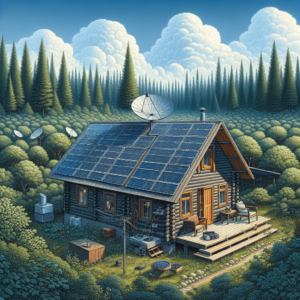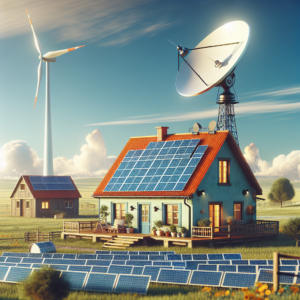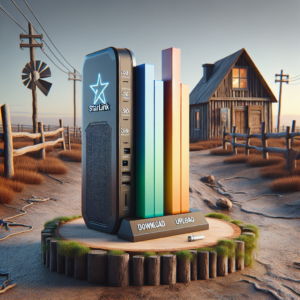
Key Takeaways:
Off-grid living typically requires an initial investment of $20,000 to $100,000, depending on system design and energy needs.
Solar power systems are a significant part of off-grid living, with costs averaging around $45,000–$65,000.
Long-term savings include no monthly utility bills and potential tax benefits.
Maintenance costs for off-grid systems can be lower due to the durability and simplicity of the systems.
Despite the upfront costs, off-grid living can increase property value and provide energy independence.
Decoding the Price of Freedom: Off-Grid Living
Imagine waking up each morning to the gentle hum of nature, with the sun’s rays providing your energy and the land offering sustenance. This isn’t a dream for those who choose to live off-grid; it’s their everyday reality. Off-grid living isn’t just a lifestyle; it’s a commitment to independence, sustainability, and, often, financial freedom. But what does it really cost to unplug from the grid?
What Does Going Off-Grid Really Mean?
Going off-grid means different things to different people, but at its core, it’s about self-sufficiency. It’s about generating your own power, sourcing your water, managing waste, and sometimes, growing your own food. It’s not just about disconnecting from public utilities; it’s about creating a life that’s less dependent on external systems and more harmonious with the environment.
Initial Investments vs. Ongoing Expenses
Before diving into the details, let’s clarify something important: off-grid living involves two types of costs. First, there are the initial investments – the upfront costs of setting up your homestead. These include buying land, installing a solar power system, and setting up water and waste management solutions. Then there are the ongoing expenses – the day-to-day costs of living, which can be significantly less than a traditional on-grid lifestyle. So, let’s break it down.
Setting the Stage: The Upfront Costs
Land Acquisition: Seeking Your Sanctuary
First things first, you need a place to call your own. The cost of land varies widely based on location, size, and accessibility. You might find a small plot for as little as $5,000 in a remote area, or you might spend upwards of $100,000 for a larger piece of land closer to amenities. It’s crucial to consider not just the price but also the suitability of the land for off-grid living – is there enough sunlight for solar panels, is it accessible during all seasons, and does it have a water source?
Solar Power Solutions: Harnessing the Sun
Solar panels are the heart of most off-grid systems. They can be pricey, but they’re a one-time investment that pays off in the long run. A typical off-grid solar system can cost anywhere from $45,000 to $65,000. This includes panels, batteries for energy storage, charge controllers, and inverters. The exact price depends on how much electricity you need and the quality of the components you choose.
Remember, solar isn’t just about the panels. You’ll need a robust battery system to store energy for when the sun isn’t shining. Batteries can be one of the most significant costs in your solar setup, but they’re also one of the most critical components for ensuring a reliable power supply.
Choose quality solar panels that match your energy needs.
Invest in a battery system with enough capacity for your household.
Don’t forget about other system components like charge controllers and inverters.
Water Systems: Tapping into Nature’s Resource
Water is life, and when living off-grid, you’ll either need to find a property with a natural water source or set up a system to collect and purify rainwater. Drilling a well can cost between $1,500 and $12,000, while rainwater collection systems vary from a few hundred dollars for simple setups to thousands for more complex ones. The key is to ensure you have a reliable and clean water source year-round.
Building Materials and Tools: Constructing Your Haven
Building your off-grid home can be as budget-friendly or as extravagant as you desire. Many off-gridders opt for sustainable materials like reclaimed wood, which can save money and reduce environmental impact. The cost of building materials and tools can range from a few thousand dollars for a tiny home to over $100,000 for a larger, more traditional house.
But let’s not forget, you’re not just building a house; you’re creating a home. That means thinking about the long-term durability of the materials you choose and the efficiency of the design. A well-insulated home, for example, will save you money on heating and cooling in the long run.
So, we’ve laid the foundation for understanding the costs of off-grid living. In the next sections, we’ll delve into the monthly outgoings and the long-term savings that make this lifestyle not only sustainable but also financially savvy.
Essential Systems: Septic, Heating, and Cooling
When you’re off the grid, you’re also off the municipal sewer system. A septic system, which is a must-have for waste management, will generally cost between $3,000 and $10,000. This includes the tank itself and the installation. Heating and cooling systems also need to be considered. Wood stoves are a popular, renewable option for heating and can range from $500 to $2,000, not including installation. Cooling might be achieved through passive solar design, which minimizes costs and maximizes natural airflow.
Efficient septic systems are crucial for a clean and healthy living environment, and while they require an upfront investment, they are typically low-maintenance once installed. Heating and cooling, on the other hand, are about smart design and choosing renewable resources to keep costs low. For instance, positioning windows for cross-ventilation can eliminate the need for air conditioning.
Monthly Outgoings: Slice Your Bills
Once your off-grid home is set up, the ongoing monthly costs are significantly lower than living on-grid. You’ve eliminated the utility bills, and your main expenses will revolve around maintenance, property taxes, and personal living costs like food and toiletries.
Energy Independence: Bye-Bye Utility Bills
One of the most liberating aspects of off-grid living is saying goodbye to monthly electricity bills. With your solar setup, you’re generating your own power and storing it for use. The only costs associated with your energy will be maintenance and eventual battery replacement, which is typically every 5 to 15 years depending on the battery type.
Water Wisdom: Conservation and Collection
Water conservation is a way of life off-grid. With systems in place to collect rainwater and perhaps a well, your water is essentially free. However, you may incur some costs with purification and pumping, but these are minimal compared to municipal water bills.
Groceries and Goods: Grow Your Own and Buy Bulk
Many off-gridders take pride in growing their own food, which can significantly reduce grocery bills. Even if you’re not a green thumb, buying in bulk and preserving food can lead to substantial savings. The key is to be mindful of your consumption and waste, maximizing what the land provides and minimizing what you need to bring in.
For example, imagine canning your own tomatoes or drying herbs from your garden. Not only does this cut down on costs, but it also ensures you have a supply of healthy, homegrown food year-round.

Hidden Gems: Long-Term Savings Unveiled
There’s more to off-grid living than meets the eye, especially when it comes to finances. Over time, the lifestyle reveals hidden savings that can make a significant impact on your wallet.
Tax Benefits and Incentives: Pocketing the Perks
Depending on where you live, there might be tax incentives for using renewable energy sources like solar power. These can offset the initial costs of setting up your off-grid system. For example, the federal solar tax credit in the United States allows you to deduct 26% of the cost of installing a solar energy system from your federal taxes.
Maintenance Minimized: The Durability of Simplicity
Off-grid systems are designed to be robust and low-maintenance. By choosing durable materials and quality components from the start, you can minimize future repair and replacement costs. Simple systems are not only easier to maintain but often outlast more complex setups.
Value Appreciation: Off-Grid as a Long-Term Investment
Living off-grid can add value to your property. As more people seek sustainable lifestyles, the demand for off-grid capable homes is growing. This means that your initial investment could pay off not just in savings and self-sufficiency but also in increased property value over time.
Realities Uncovered: The Challenges Ahead
While off-grid living can be idyllic, it’s not without its challenges. Preparing for nature’s unpredictability and ensuring you have the skills to maintain your home are just the beginning.
For instance, you’ll need to be ready for everything from solar panel upkeep to troubleshooting your water system. It’s not always easy, but for many, the rewards of self-reliance and harmony with nature are worth every challenge.
And there you have it. A comprehensive look at the costs of off-grid living, from the initial investment to the ongoing expenses and hidden savings. It’s a lifestyle that requires planning, dedication, and a bit of courage, but the payoff is a life of freedom, sustainability, and financial independence. If you’re ready to take the plunge, remember that every step you take towards off-grid living is a step towards a more sustainable future for us all.
Legalities and Logistics: Navigating Red Tape
Stepping into off-grid living isn’t just about the land and technology; it’s also about understanding and complying with local laws and regulations. Zoning laws, building codes, and environmental regulations can all impact your off-grid plans. It’s essential to do your homework before you build or install anything. Sometimes, you might need permits or inspections to ensure everything is up to code, which can add to your initial costs. But it’s better to be safe and legal than face fines or be forced to undo your hard work.
Community and Accessibility: Remote, Not Isolated
Off-grid living often means being far from urban centers, but that doesn’t have to mean isolation. Many off-grid communities are tight-knit, with neighbors sharing resources and knowledge. It’s essential to consider how you’ll access necessities like medical care, education, and supplies. While living off-grid can reduce many costs, you may incur additional expenses for transportation or to bring in specialized services or goods.
Remember, part of the beauty of off-grid living is the community you can build or become a part of. These relationships can be invaluable, providing support and camaraderie as you navigate your new lifestyle.
Accessibility is also a practical consideration. If your off-grid home is too remote, it might be challenging to access in inclement weather or emergencies. Therefore, when choosing your land, consider not only the cost and natural resources but also the location and accessibility.
Research local laws and obtain necessary permits.
Consider the proximity to off-grid communities for support and resource sharing.
Ensure your location is accessible for emergencies and necessary services.
Frequently Asked Questions (FAQ)
How do I determine how much off-grid living will cost me?
To estimate the cost of off-grid living, start by assessing your energy needs. Calculate the power consumption of your home and determine the size of the solar system required. Next, factor in the cost of land, water systems, and building materials. Don’t forget to include the price of any permits or inspections needed. Keep in mind that while the initial investment might be significant, the long-term savings on utility bills can be substantial.
For a more precise figure, consider consulting with professionals who have experience in off-grid setups. They can provide you with a detailed breakdown based on your specific circumstances and location.
Is going off-grid a reliable way to save money?
Yes, going off-grid can be a reliable way to save money in the long term. While the upfront costs are considerable, the ongoing expenses are typically much lower than living on the grid. You’ll save on monthly utility bills, and if you grow your own food and use water wisely, you can significantly reduce your living costs. Plus, there are potential tax benefits and incentives for using renewable energy.
What are common unforeseen costs in off-grid living?
Unforeseen costs in off-grid living can include repairs and replacements for solar equipment, higher-than-expected costs for drilling a well or installing a septic system, and transportation costs for accessing remote locations. It’s also wise to have a contingency fund for emergencies or unexpected legal issues related to zoning or building codes.
How do solar incentives affect off-grid living expenses?
Solar incentives can significantly reduce the initial costs of setting up an off-grid system. These incentives might come in the form of tax credits, rebates, or grants. They can lower the cost of solar panels, batteries, and other equipment, making the transition to off-grid living more affordable. Be sure to research the incentives available in your area and factor these into your budgeting.
Can off-grid investment increase my property’s value?
An off-grid investment can increase your property’s value, especially as more people seek sustainable and independent lifestyles. Homes that are self-sufficient with reliable water and power sources are attractive to a growing segment of homebuyers. This means that your investment in off-grid infrastructure can not only save you money over time but could also pay off if you ever decide to sell your property.







